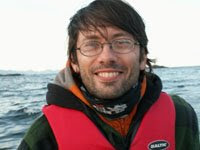 Fantasy Masterworks: Three Hearts & Three Lions by Poul Anderson (published by Gollanz, 177 pages, ISBN 0575074981)
Fantasy Masterworks: Three Hearts & Three Lions by Poul Anderson (published by Gollanz, 177 pages, ISBN 0575074981)NOTE: This review contains some spoilers. For those who do not wish to spoil the reading of this book the summary follows here; read it. It is a fantastic tale which has influenced the very structure of how we play roleplaying games. Additionally it is strongly recommended to Ars Magica players and game masters as an inspirational resource, and WFRP and D&D players will find it worthwhile reading as well.
Now on with the review.
Three Hearts & Three Lions is one of the books in the fantasy genre that has most influenced the origin of roleplaying games. The book was originally published in 1953 and tells the tale of Holger Carlsen, an engineer who during the second world war is whisked away to another dimension, where fantastical elements exist in a world which otherwise shares a common history with our own. Myth and historical events are mixed together to create a setting very much reminiscent of the Ars Magica world, and also of Greyhawk for D&D.
The world Holger enters is one where the events of the Carolingian cycle are historical facts (read more about that here). Now once again the forces of chaos are massing for an assault on humanity and all that is lawful and good. Faeriedom is a principal force in this conflict which Holger soon comes into conflict with. As he does battle with various agents of chaos he struggles to remember why this fantastical world seems so familiar, and how he can return to our own world.
I decided to read this book not because it was the first listed as recommended reading in the first edition Dungeon Master’s Guide for D&D, but because it kept cropping up in discussions on EN World when people asked where the D&D troll came from. Since that monster concept was apparently lifted wholesale from Three Hearts & Three Lions, I decided to educated myself. It is also cited as a major influence by Micheal Moorcock which in itself piqued my interest.
Right from the start it was obvious that this book has contributed much to the shape of fantasy roleplaying. Apart from the monsters appearing, which all are present in most of the major fantasy roleplaying games, our hero Holger soon assembles a small adventuring party, and they are after a while given a quest in true roleplaying style. They have encounters, some more random than others, where they must use their skills and wit to survive. They are even joined by a new player … sorry, a new member of their party a bit over halfway through the book.
Just about the only weakness I found in regards to structure is that the quest basically is a monster parade. The hero rides about a bit, encounters a monster who is defeated, and then rides onward encountering another monster, and so on so forth. This is a minor complaint but the structure is very much the same as an uninspired series of wilderness adventures för D&D. This works well in the book since the story contains many other complications as well as the developlment of the main protagonists, but if it was an adventure to be played, it would not make for an inspired experience.
One funny detail is that the edition I read contained an inordinate amount of typos, especially at the end of the book. There’s no escape, it seems.
It must be noted that for many roleplaying gamers much of the story and the events will seem familiar. We have seen them and played them over and over again ourselves, so there might be a risk of a reader feeling a bit underwhelmed. But remember that this is one of the sources for many of the clichés we inflict upon our selves, the origin if you will. I still think that anyone who thinks of himself or herself as a gamer should read this book. It is masterfully written and effectively proves that an author does not need a trilogy or a thousand pages to conjure up a fantastical setting and fabulous adventures. It also shows that fantasy is so much more than endless rehashing of the Tolkien legacy.
Magnus


No comments:
Post a Comment